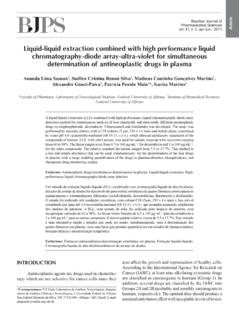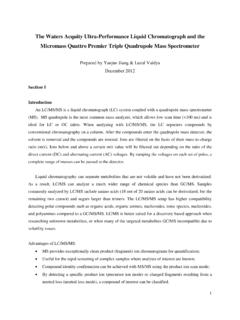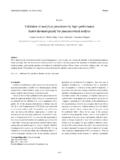Transcription of 7. Thin-Layer Chromatography - Chemistry Courses
1 937. Thin-Layer ChromatographyYou will need to bring your package of TLC plates on this day. Not all plates will be used inthis experiment; some will be needed in lab the following week. Be sure to include all theanalgesics and solvents used in this experiment in your Chemical Data Tables. Don t forget toinclude the Chromatographic Behavior Comparison section in this PreLab. An example can befound in section exercise:Using a greatly magnified diagram of a TLC plate, locate or define each of the following terms:1. Origin2. Stationary Phase3. Mobile Phase4. Solvent Front5. Component spot 6. Rf value7. Development8. Visualization of spots9. What is meant by differential partitioning between stationary and mobile phase?10. What is the recommended procedure for cleaning a TLC spotting capillary?IntroductionChromatography is the separation of two or more compounds or ions by the distributionbetween two phases, one which is moving and the other which is stationary.
2 These two phasescan be solid-liquid, liquid-liquid or gas-liquid. Although there are many different variations ofchromatography, the principles are essentially the same. If you took Chem 15 at University Park,you may remember using paper Chromatography to separate inks and food dyes. The cellulosepaper was the stationary or solid phase and the 1-propanol/water mixture was the mobile or liquidphase. This chapter explores a very similar microscale technique for separating organicmolecules, Thin-Layer Chromatography or TLC, is a solid-liquid form of Chromatography where thestationary phase is normally a polar absorbent and the mobile phase can be a single solvent orcombination of solvents. TLC is a quick, inexpensive microscale technique that can be used to: determine the number of components in a mixture verify a substance s identity monitor the progress of a reaction determine appropriate conditions for column Chromatography analyze the fractions obtained from column chromatogrpahyIn paper Chromatography , the stationary phase is a specially manufactured porous paper.
3 Thesamples are added to one end of the sheet of paper and dipped into the liquid or mobile phase. Thesolvent is drawn through the paper by capillary action and the molecules are distributed bypartition between the mobile and stationary phase. The partition coefficient, k, similar to thedistribution coefficient for extraction, is the equilibrium constant for the distribution of moleculesbetween the mobile phase and the stationary phase. It is this equilibrium that separates thecomponents. Different inks and dyes, depending on their molecular structures and interactionswith the paper and mobile phase, will adhere to the paper more or less than the other compoundsallowing a quick and efficient works on the same principles. In Thin-Layer Chromatography , the stationary phase is apolar absorbent, usually finely ground alumina or silica particles.
4 This absorbent is coated on aglass slide or plastic sheet creating a thin layer of the particular stationary phase. Almost allmixtures of solvents can be used as the mobile phase. By manipulating the mobile phase, organiccompounds can be ExerciseDefinition ofChromatographyPaperChromatography94 TheoryTo thoroughly understand the process of TLC, as well as all types of Chromatography , we musttravel to the molecular level. All forms of Chromatography involve a dynamic and rapidequilibrium of molecules between the two phases. As shown in Figure , there are:1. free - completely dissolved in the liquid or gaseous mobile phase and2. absorbed - stuck on the surface of the solid stationary are continuously moving back and forth between the free and absorbed states withmillions of molecules absorbing and millions of other molecules desorbing each second.
5 Theequilibrium between the free and absorbed states depends on three factors: the polarity and size of the molecule the polarity of the stationary phase the polarity of the solventThus, one has three different variables to change in Chromatography . The polarity of themolecules is determined by their structures. By selecting different stationary and mobile phases,one can change the equilibrium between the free and absorbed states. It is important to understandchromatography at this molecular level because this allows one to choose mobile and stationaryphases that will separate just about any mixture of molecules partition differently between the free and absorbed state, that is theequilibria between these two states is not the same. In Fig. below, molecule A is weaklyabsorbed, its equilibrium lies in the direction of the free state and there is a higher concentrationin the mobile phase.
6 Molecule B, on the other hand, is strongly absorbed, its equilibrium lies inthe direction of the absorbed state, and has a higher concentration on the stationary : Mixture of A & B free in mobile phase and absorbed on the stationary : Dynamic equilibrium between A & B and the mobile and stationary Level95In TLC, the stationary phase is typically alumina ( )n or silica gel ( ) covalent network of these absorbents create very polar materials. The structure of silica isshown adding your mixture to a combination of a mobile phase and a stationary phase will notseparate it into its pure molecular components. For this to happen, the mobile phase must flowpast the stationary phase as depicted in Fig. Since the A molecules spend more time in themobile phase, they will be carried through the stationary phase faster and move farther in a givenamount of time.
7 Since B is absorbed to the stationary phase more than A, B molecules spend lesstime in the mobile phase and therefore move through the stationary phase particles more B molecules don t move as far in the same amount of consequences of this flowing mobile phase is that A is gradually separated from B bymoving ahead in the flow. This separation process is depicted in Figure phase flowMobile phase flowMobile phase flowMobile phase flowFigure : Mixture of A & B separated by a moving mobile phase while being absorbed onthe stationary : Structure of Silica ( ) separation of amixture ofmolecules A & B. +SiOOSilica96 Figure : Common Stationary Phases listed by Increasing that we understand how the stationary phase operates, and assuming we are using a polarabsorbent, how can we determine the elution sequence for our particular mixture?
8 As mentionedpreviously, the more polar compounds will adhere more strongly to the stationary phase. lists several common compound classes according to how they will elute from silica : Elution Order for Some Common Functional Groups from Silica or electropositive character of the aluminum or silicon and the electronegative oxygen createa very polar stationary phase. Therefore, the more polar the molecule to be separated, the strongerthe attractive force to the stationary phase. In some sense, the old adage like-dissolves-like canbe applied here. The polar stationary phase will more strongly attract like or polar molecules. Theequilibrium will be shifted as the molecules remain on the stationary phase. Nonpolar moleculeswill have a lower affinity for the stationary phase and will remain in the solvent longer.
9 This isessentially how the partitioning separates the molecules. The equilibrium governs the separation,but the component s attraction to the stationary phase versus the mobile phase determines theequilibrium. In general, the more polar the functional group, the stronger the bond to the stationaryphase and the more slowly the molecules will move. In an extreme situation, the molecules willnot move at all. This problem can be ovecome by increasing the polarity of the mobile phase sothat the equilibrium between the free and absorbed state is shifted towards the free. Although alumina and silica are the most common stationary phases used for TLC, there aremany different types . They range from paper to charcoal, nonpolar to polar, and reverse phaseto normal phase. Several different types of stationary phases are listed according to polarity inFigure OSiOSIOSiOSiOH3CH3CH3CH3CH3CH3CH3CH3C OOOC arbowax polymer OSI(CH2)17-CH3CH3CH3C-18 reverse phaseChromatography Stationary Phase PolaritiesPolydimethyl siloxane*Methyl/Phenylsiloxane*Cyanoprop ylsiloxane*Carbowax (polyethyleneglycol)*Reverse Phase (hydrocarbon-coated silica C-18)PaperCelluloseStarchCalcium sulfateSilica (silica gel)Florisil (magnesium silicate)Magnesium oxideAlumina (aluminum oxide; acidic, basic or neutral)Activated carbon (charcoal.)
10 Norit pellets)*GC stationary phasesIncreasing PolarityElution Sequence by Functional Group(using Silica or Alumina TLC or Column Chromatography )Highest/Fastest (elute with nonpolar mobile phase)Alkane HydrocarbonsAlkyl Halides (Halocarbons)Alkenes (Olefins)DienesAromatic hydrocarbonsAromatic halidesEthersEstersKetonesAldehydesAmine sAlcoholsPhenolsCarboxylic acidsSulfonic acidsLowest/Slowest (need polar mobile phase to elute)Increasi ng Functional Group Pol ari ty97 You may be able to see a trend developing. In general, the more nonpolar the compound, thefaster it will elute (or the less time it will remain on the stationary phase) and the more polar thecompound the slower it will elute (or more time on the stationary phase). It is important to becomefamiliar with the trend so that you will not have to rely on the chart. You should be able torecognize the functional groups and easily determine which one is more polar than , it should be noted that Chromatography is not an exact science.







